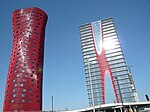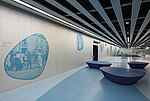Plaça d'Europa

Plaça d'Europa (official name in Catalan, in Spanish: Plaza de Europa) is a square in the District VII (Granvia l'Hospitalet) of L'Hospitalet de Llobregat suburb of Barcelona, Catalonia in Spain. Located on the Granvia de l'Hospitalet avenue at the intersection with Carrer d'Amadeu Torner. It is part of L'Hospitalet's recent urban development, and one of its biggest squares at 33 ha, with a distinguishable skyline made up of high-rises, among the tallest structures in the city, some of which are designed by the renowned architect Toyo Ito. It is expected to become its economic centre, and will allow different parts of the city formerly severed by the Granvia to become interconnected. It is still not completed but already featuring most of its planned buildings and infrastructure. Part of Fira de Barcelona, near it stand the pavilions of rest of Fira de Barcelona and the shopping centre Gran Via 2.
Excerpt from the Wikipedia article Plaça d'Europa (License: CC BY-SA 3.0, Authors, Images).Plaça d'Europa
Plaça d'Europa, l'Hospitalet de Llobregat
Geographical coordinates (GPS) Address Nearby Places Show on map
Geographical coordinates (GPS)
| Latitude | Longitude |
|---|---|
| N 41.357049 ° | E 2.124813 ° |
Address
Europa-Fira
Plaça d'Europa
08908 l'Hospitalet de Llobregat (Districte III)
Catalonia, Spain
Open on Google Maps










